
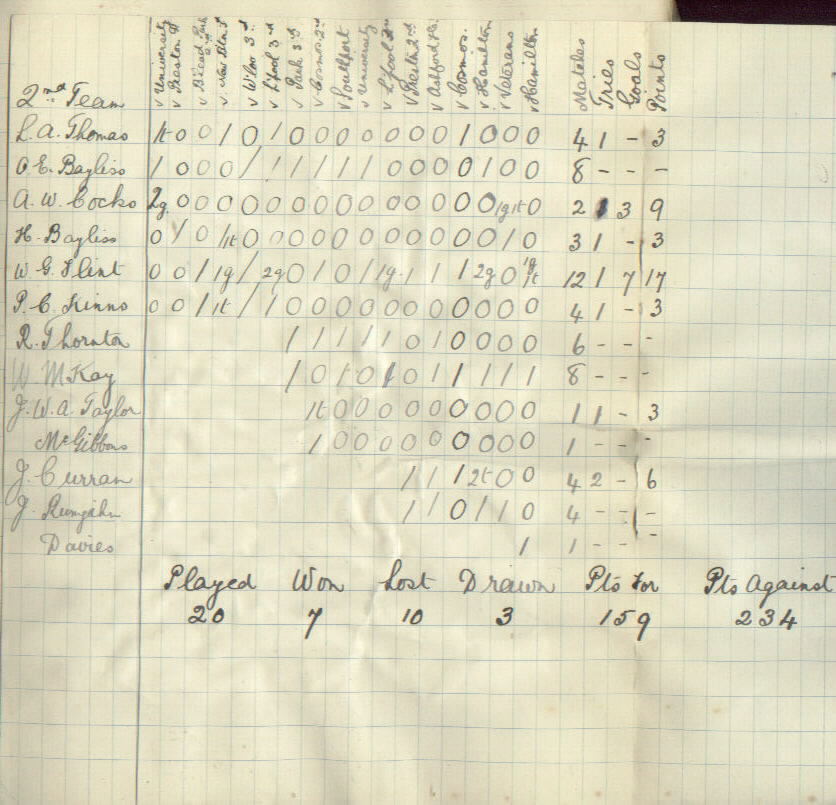
An Alien at War
Percy Charles Kinns
Written and researched by David Bohl, with the kind help and documents supplied by World War 1 historians worldwide.
Percy Kinns was born in Hertford in 1892 and after teacher training at St John's College, Battersea he moved up to Liverpool take up a teaching post. He was elected a member of the Alien5, documented in the 1912/13 minutes, and played out the early part of the season in the Second fifteen.


At the beginning of WW1 he joined up in the King's Liverpool Regiment.

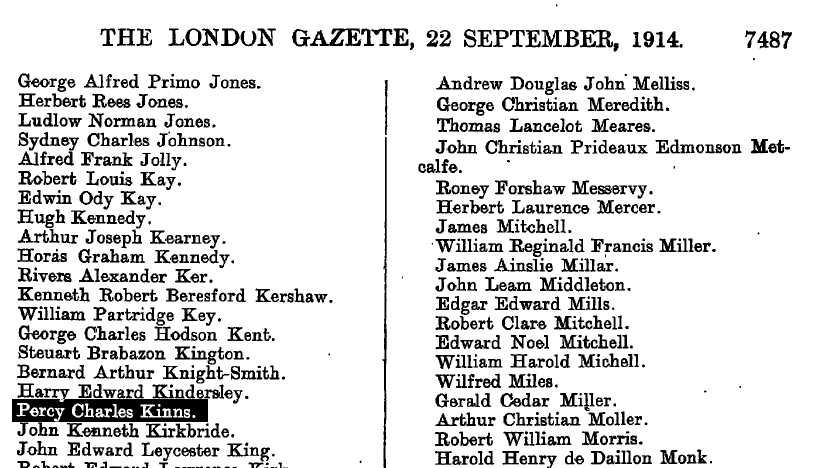
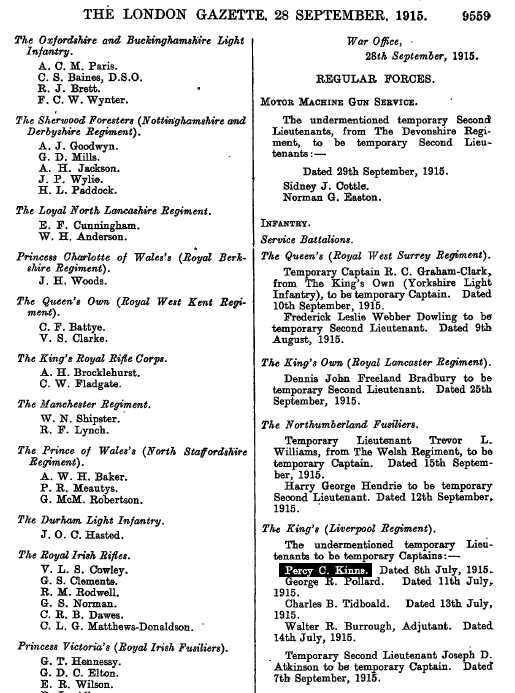
August 1916 - Listed as wounded in Straits Times (Singapore)

June 1917 - From Service Battalion as Temp. Captain
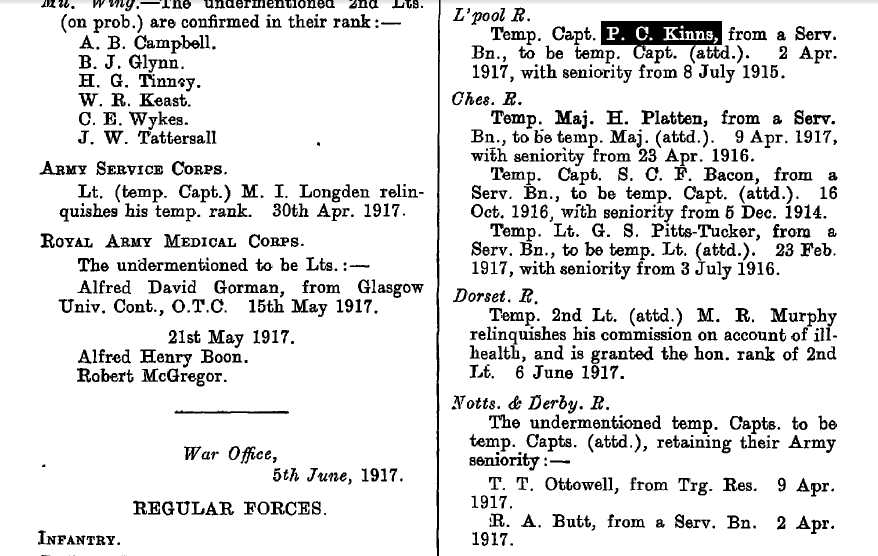
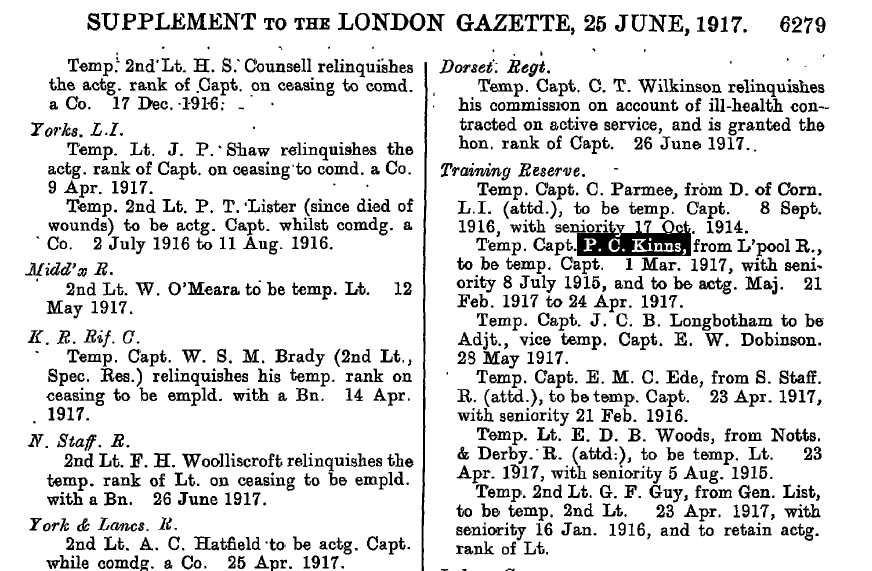
October 1917 - Joins Indian Army Reserve of Officers
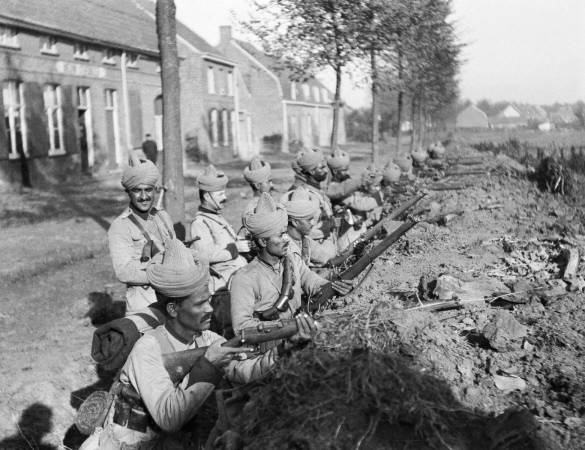
Copyright The Imperial War Museum
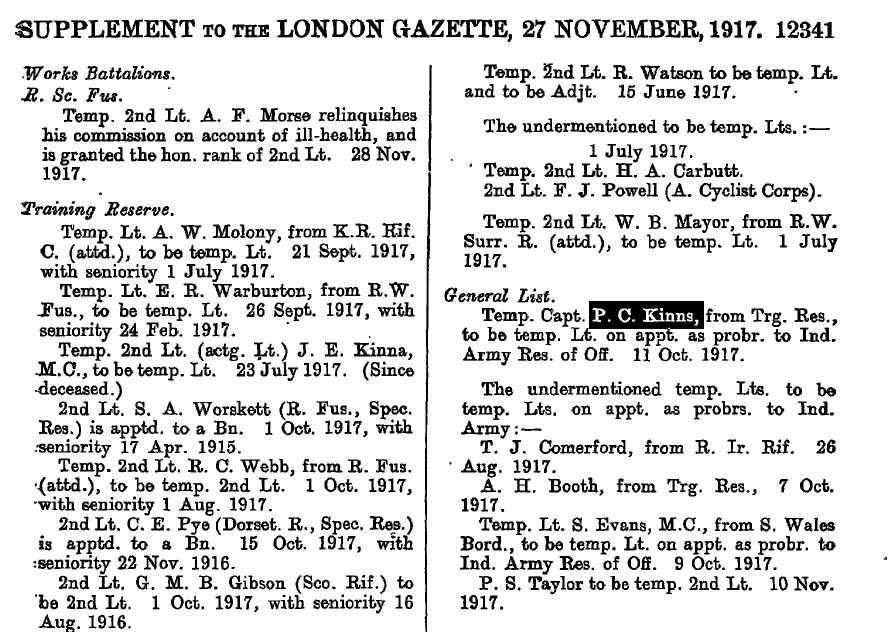
December 1917 - Promoted to Lieutenant
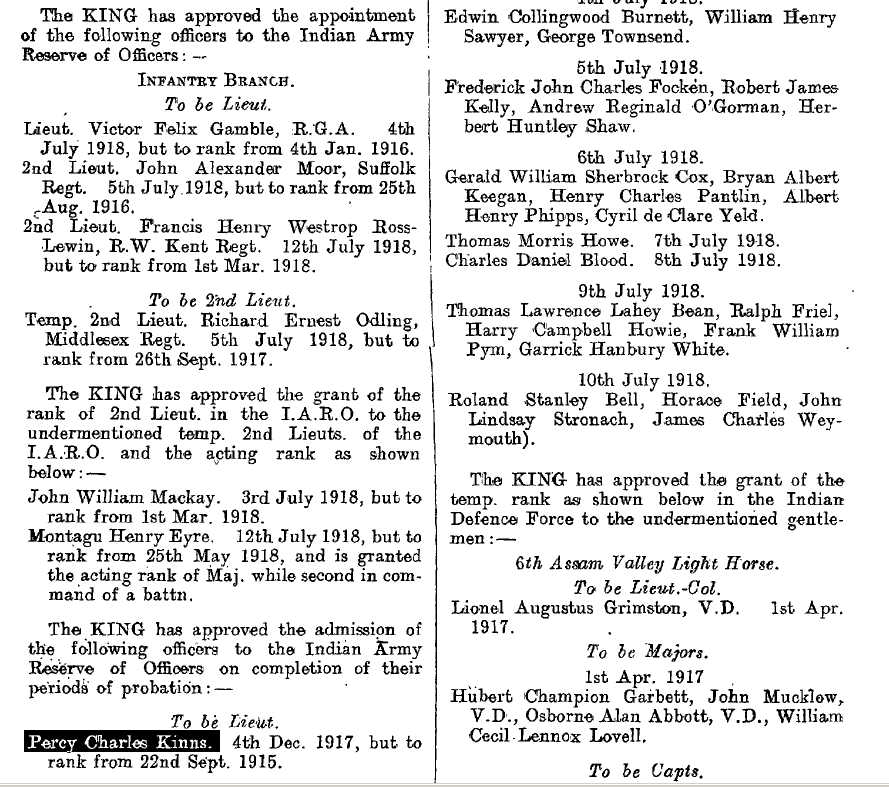
July 1918 - Joins 31st Punjabis as Acting Captain
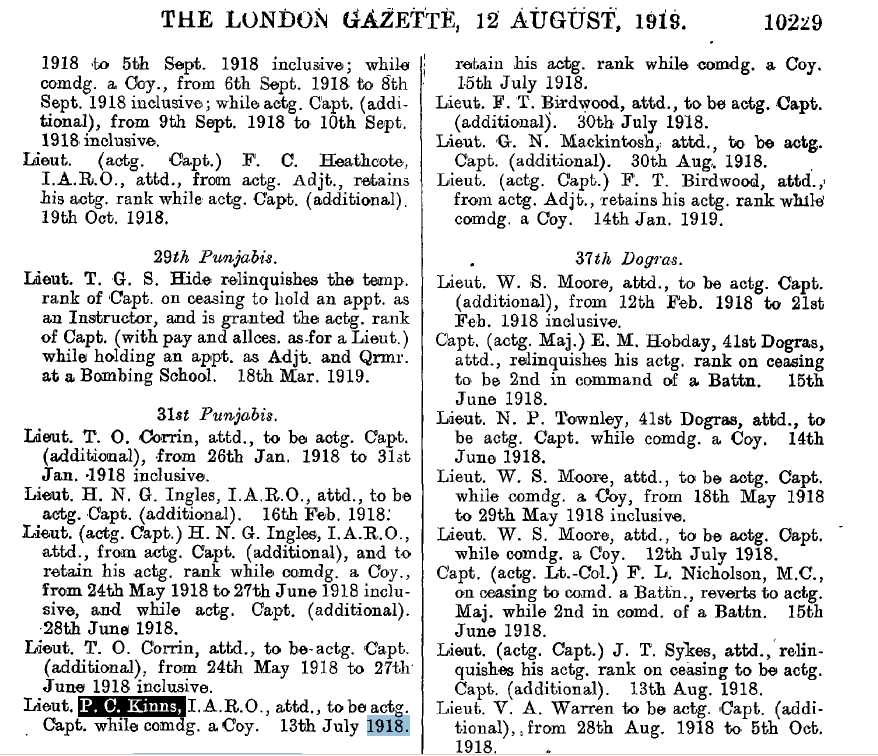
During the First World War, the 31st Punjabis served in Mesopotamia and Salonika in Greece. It then served at Constantinople, Turkey as part of Allied occupation forces
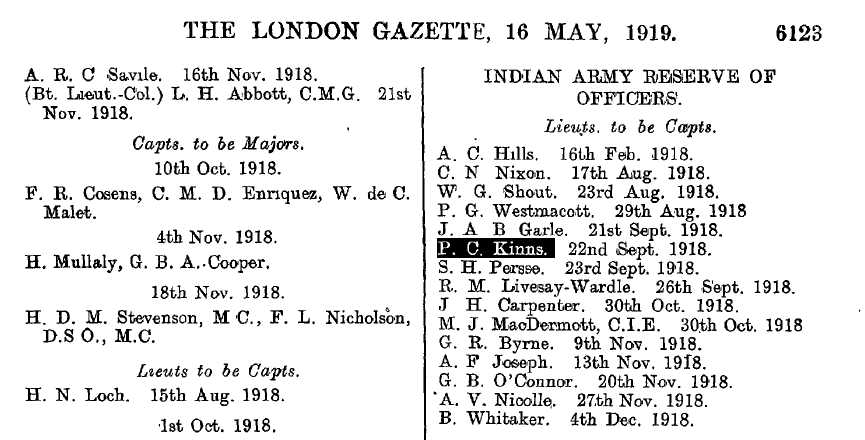
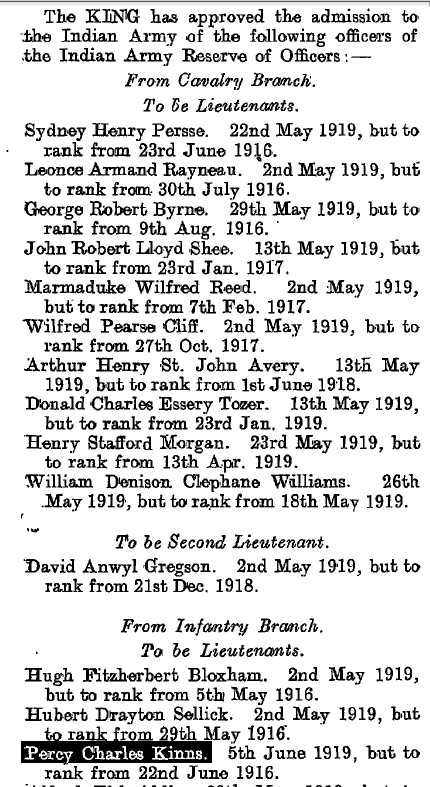
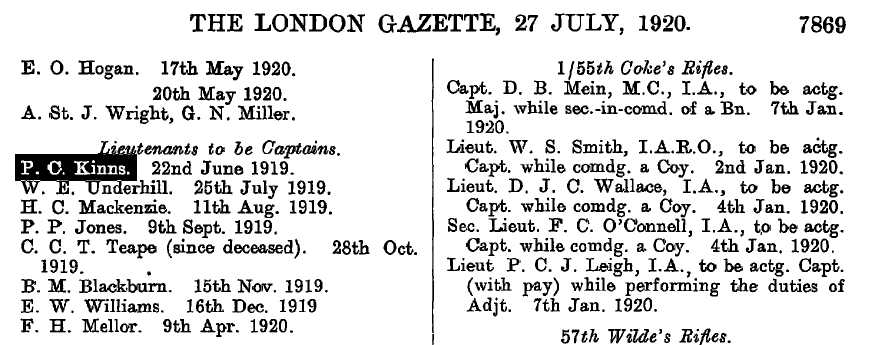
1920 National Union of Teachers
Listing

The vast scale of the Great War
and the heavy casualties
sustained
meant that officers needed to be found badly to fill vacancies in
established and newly raised units.
One very important source for this was the I.A.R.O. (Indian Army
Reserve of Officers). Many men in the I.A.R.O. lived and worked in
India and often had some military background.
Although not career soldiers, Indian Army Reserve Officers often
received high praise from the units that received them, and did much
valuable work in which ever theatre they found themselves.
In the early 1920's, when the Indian Army drastically reduced its size
to a peacetime establishment, the vast majority of Indian Army Reserve
officers left the Army and returned to their civilian lives, although a
few received regular commissions and stayed on. (Comment from Great War
Forum)
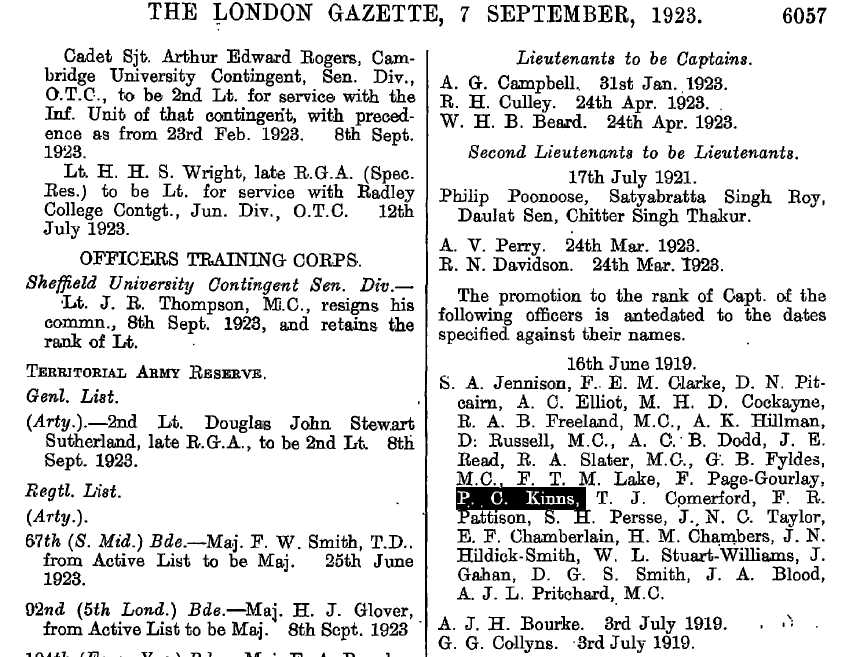
He married at St John's Afghan Memorial Church in Bombay, India in 1924.
There are passenger records of their movements to the area:-
1927 Liverpool to Bombay (Percy and Phoebe Elsie)
1930 Liverpool to Port Said, Egypt (Percy and Phoebe Elsie)
1934 Liverpool to Karachi
1939 Liverpool to Bombay (Phoebe Elsie)
July 1933 - Promoted to Major
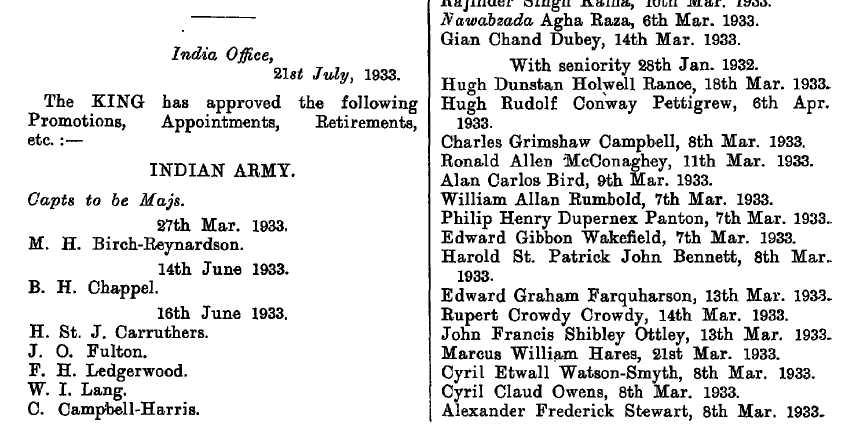
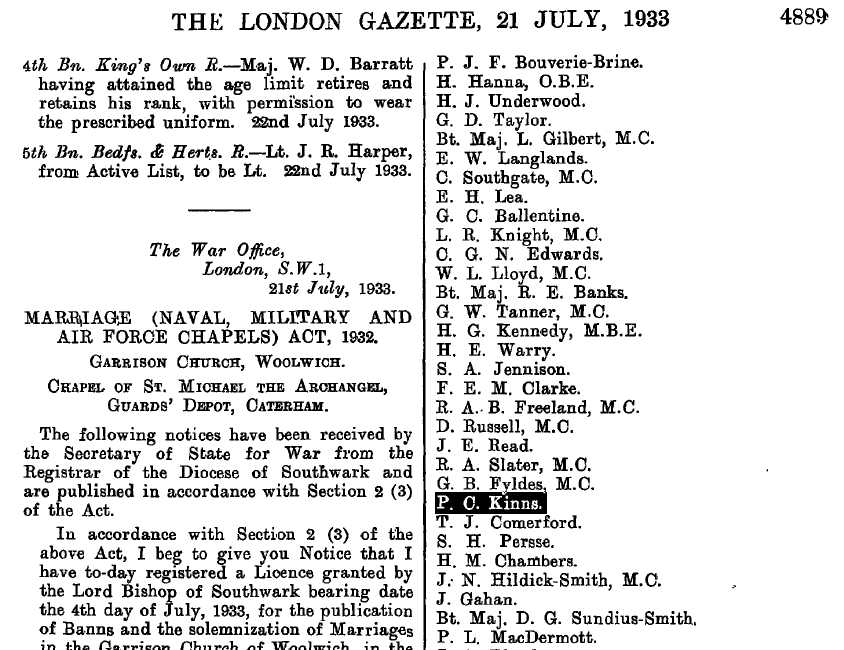
August 1941 - Promoted to Lieutenant Colonel
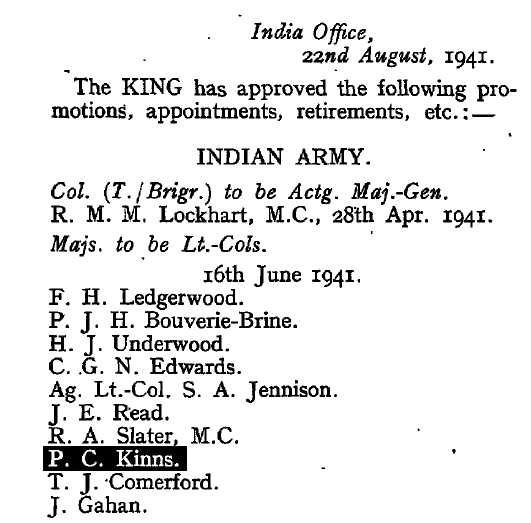
|
|
|
|
King's Liverpool Regiment |
Punjab Regiment |
Percy passed away in Jersey General Hospital on 23rd July 1963
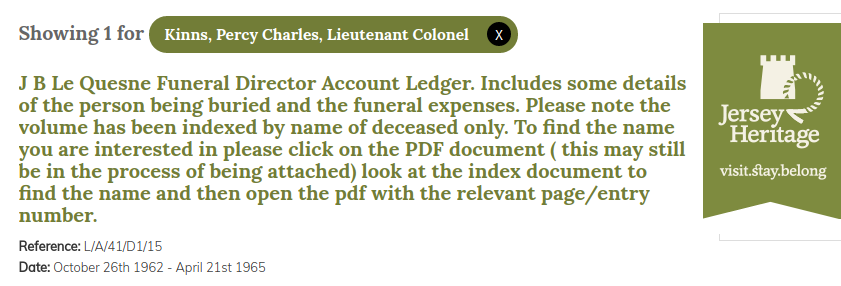
Lt-Col Percy Charles Kinns
(1892-1963)
Appendix:- The Baloch Regiment
Narrative from Pakistan Defence Forum defencepk.com/forums/
v.1.0 September 11, 2002
Babar Mahmud
Editor’s Note: This regiment was earlier called the Baluch
Regiment, after the Pakistan province of Baluchistan. This spelling and
pronunciation were, however, inherited from colonial days. The
Pakistani pronounciation of the Baluch is Baloch, with the ch as in
change.
The Baloch regiment is second in seniority after the Punjab Regiment in
the Pakistan Army. Its oldest battalion was raised more than two
hundred years ago, in 1798 AD at Masulipattam, as the Macleod Ki Paltan
[Macleod’s force], now the 1st Baloch. After raising, it
later
became the 89th Punjabis and was followed by 90th, 91st and 93rd Punjab
Battalions. Combined these arms were given the title of the Madras
Native Infantry.
‘It was the Madras Army’ says the regimental
historian,
‘that was responsible to oust the French from the India. The
battalions fought valiantly in expeditions that resulted in the
unification of the territories which now make up India and modern
Burma’.
Storming through the jungles of Burma in the same century, uttering
their blood-chilling battle cries, the Baluchis also led the fight to
conquer that country and their name became immortalized as the
‘Burma’ battalions. In honor of their courage and
valor the
battalions were presented with an image of the mythical Burmese god,
Chinthe, Which they adopted as their cap badge.
The Baluchis are formidable fighting men. Through two centuries their
lustrous deeds in campaigns throughout the sub-continent and in World
War I and afterwards are writ large in the history of valor.
One of the battalions raised in the first half of 19th century so
distinguished itself on the battlefields of Europe and Palestine; it
earned the name of the ‘Bombay Toughs’. Another,
the 124th,
raised in 1905, became the ‘War Babies’- for their
youth
and the courage they displayed in Palestine in 1918.
Many awards for courage were won the Baluchis in the First World War
and subsequently in campaigns across the sub-continent and in the
Second World War.
These including the first Victoria Cross ever awarded to an Indian
soldier, not only a Muslim but also a Balochi: Lance Naik Khudad Dad
Khan of the old
4th Baloch, now 11th Baloch. For their fighting distinction and sheer
courage in WWI, the British Government in India bestowed a noble
monument in the gardens of Frere Hall, Karachi commemorating the
officers, JCOs and men of the 10th Baloch Regiment who fell in battle
which still stands.
Another unique distinction in the regimental honor is that of the
George Cross, Britain’s peacetime equivalent of the Victoria
Cross, which was awarded to Captain Durrani of the 1st Bahawalpur
Regiment, now the 8th Baloch.
Altogether in its first 150 years, the regiment gathered one of the
most distinguished records for bravery in military history, including
fourteen Victoria Crosses, one George Cross, one CMC, 36 DSOs, 158 MCs,
Service medals and civil honors and more than 350 mentions in
dispatches.
The Baloch Regiment like the Punjab Regiment and the Frontier Force
Regiment are three British origin infantry regiments in Pakistan Army.
The British ruled this area nearly 200 years and an Army
Commander-in-Chief was always number two in rank after the
Viceroy/Governor General in the sub-Continent. "Sub-Continent" means
present day Pakistan, India, Bangladesh and Burma. The British
originally had three different armies to control this region, Bengal
Army, Bombay Army and Madras Army. These three armies were united in
1895 as British Indian Army. More than 500 states were also working
under British India, most of them, especially big states, had their own
state forces.
Present Baloch Regiment have its origin in Bombay Army, Madras Army and
in State Forces of Bahawalpur in southern Punjab.
Part of the Baluch Regiment’s origin is from the old Bombay
Army
raised in early nineteenth century , the senior battalion originated in
the 2nd (Marine) Bn of the 12th Regiment of Bombay Native Infantry
raised in 1820. In 1838, as the 24th Regiment of Bombay Native
Infantry, they stormed Aden (Yemen), bringing that hotbed of pirates
under the British flag. The 26th Bombay Native Infantry was raised in
1825 as the 2nd Extra Bn of Bombay Native Infantry, changing its name a
year later. Sir Charles Napier raised two regiments in Karachi - the
1st and 2nd Baloch Regiments - for local service within Sind in 1844
and 1846 respectively.
The term 'local' was interpreted fairly loosely when it became
necessary to send the 2nd Baloch to the Persian War in 1856-57, a
campaign frequently overshadowed by the events of the Independence War
of Indian People (Great Mutiny by British) in 1857. The 1st was in
Karachi when the news of the insurrection reached the Commissioner. Sir
Bartle Frere dispatched them with all haste, on foot across the Sindh
desert in May to join the siege artillery train on its way to Delhi,
the only Bombay unit to join the Delhi Field Force. The regiment was
brought into the regular line for its services in Central India and it
became the 27th Regiment of Bombay Native Infantry in the post-Mutiny
realignment.
The 2nd Baloch, in the meantime, had qualified for a similar change in
status for their work on the NW Frontier and became the 29th Regiment
of Bombay Native Infantry. In 1858, Major John Jacob raised a local
battalion, soon to be known as Jacob's Rifles and they made such a
reputation in and around Jacobabad that they, too, were accorded
regular status, becoming the 30th Regiment of Bombay Native Infantry or
Jacob's Rifles in 1861. In the years which followed, the subsidiary
title lapsed and does not appear to have been officially revived until
1910, by which time, the 24th, the 26th, the 27th, the 29th, and the
30th had all had one hundred added to their numbers in 1903, emerging
as the 124th, the 126th, the 127th, the 129th and the 130th.
A distinction shared by no other regiment was a spell in Japan by the
29th in 1864. They were summoned from Shanghai to Yokohama in September
to protect Queen Victoria's British and Indian subjects. The British
force remained in Japan until September the following year.
The Baloch Regiment also owed its origins to the old Madras Army due to
amalgamation of 8 Punjab in 1956 after re-organization of all Pakistan
Infantry regiments. The 29th Madras Infantry was mustered out on 15 Oct
1893 and was reconstituted the next day at Meiktila in Central Burma as
the 29th (7th Burma Bn) Madras Infantry, made up of Punjabis and Sikhs.
Similarly, the 30th Madras Infantry became the 30th (5th Burma Bn)
Madras Infantry, the 31st became the 31st (6th Burma Bn) Madras
Infantry, the 32nd became the 32nd (4th Burma Bn) Madras Infantry and
the 33rd the 33rd (3rd Burma Bn) Madras Infantry. In 1901, all these
titles were simplified by removal of all mention of Madras and the five
regiments were styled 29th Burma Infantry, 30th Burma Infantry, 31st
Burma Light Infantry, 32nd Burma Infantry and 33rd Burma Infantry.
These Burma battalions were to police the troublesome new territories
acquired in the Third Burma War. In 1903, when all Madras regiments had
sixty added to their numbers, the 29th and 30th became 89th and 90th
Punjabis, the 31st became the 91st Punjabis (Light Infantry), the 32nd
became the 92nd Punjabis whilst the 33rd only performed a half-change,
entering the new Line as the 93rd Burma Infantry. It may be said that
it was the Afghan Campaign of 1878-80 which set the seal on the future
of the Madras soldier. The 30th Madras Native Infantry served in the
Khyber Pass but suffered so much from extremes of cold that it put into
doubt the suitability of the Southern soldier for service in what was
clearly to be a recurring trouble spot.
Performance of present Baloch Regiment’s units in FIRST WORLD
WAR
124th Duchess of Connaught's Baluchistan Infantry - India, Mesopotamia,
Persia.
2/124th (formed in 1916)- Persia, Mesopotamia, Egypt, India.
3/124th (formed in 1917)- India, Persia, Mesopotamia.
126th Baluchistan Infantry - India, Egypt, Muscat, Aden, Mosopotamia.
2/126th (formed in 1918) - India.
127th Queen Mary's Own Baluch Light Infantry - India, East Africa,
Persia.
2/127th (formed in 1918) - India, Egypt.
129th Duke of Connaught's Own Baluchis - India, France, East Africa.
2/129th (formed in 1917) - India, Mesopotamia.
130th King George's Own Baluchis (Jacob's Rifles) - India, East Africa.
2/130th (formed in 1918) - India.
Only the 2nd Bn of the 124th of the wartime raisings was retained after
the post-war reforms.
The 129th in the 3rd (Lahore) Division, was the only battalion of the
regiment to serve on the Western Front, the first Indian regiment to
attack the Germans, the first also on two other counts - to lose the
first British officer and to earn the first Victoria Cross, this by
Sepoy Khudadad Khan at Hollebeke. Wounded, he recovered to enjoy the
distinction of being the first Indian soldier to receive the King
Emperor's most coveted gift. Prior to 1911, Indian soldiers had not
been eligible to receive the Cross.
89th Punjabis - India, Aden, Egypt, Gallipoli, France, Mesopotamia,
Greece, Russia.
2/89th Punjabis (raised in 1917) - India, Mesopotamia 90th Punjabis -
India, Mesopotamia
2/90th Punjabis (raised in 1918) - India
91st Punjabis - India, Mesopotamia, Egypt
2/91st Punjabis (raised in 1918) - India, Egypt
92nd Punjabis - India, Mesopotamia, Egypt
93rd Burma Infantry - India, Egypt, France, Mesopotamia, Burma
Following the return of Indian troops after the war, all the second
battalions were disbanded with the exception of the 2/89th Punjabis.
After the First World War, a major re-organization of British Indian
Army took place. Most of the wartime units were disbanded and merged
with each other. A new Regiment in the name of 10 Baloch was formed in
1922/23
At Rajkot (Rajasthan) with composition of Punjabi Muslims, Pathans,
Baluchis and Brahuis. Balochi and Brahuis are two great tribal origin
peoples of Balochistan province (now in Pakistan). Balochies are also
constituted a major part of population of Sindh Province (also in
Pakistan). Pathans are great warriors from the NWFP and West Punjab
(both are also in Pakistan). The Baloch Regiment is the only one which
represents all of Pakistan’s provinces.
The badge chosen for the 10th Baluch Regiment in 1923 was a Roman 'Ten'
within a crescent moon, a crown above and title scroll below.
The line-up of battalions for the new regiment was as under:
124th Duchess of Connaught's Own Baluchistan Infantry redesignated
as1st Bn.
126th Baluchistan Infantry - redesignated as2nd Bn
127th Queen Mary's Own Baluch Light Infantry - redesignated as 3rd Bn
(Queen Mary's Own)
129th Duke of Connaught's Own Baluchis - redesignated as 4th Bn (Duke
of Connaught's Own)
130th King George's Own Baluchis - redesignated as 5th Bn (King
George's Own) (Jacobs Rifles) 10th Baluch Regiment.
2/124th Duchess of Connaught's Own Baluchistan Infantry - redesignated
as 10th Bn
There was no Territorial battalion but the 5/10th was selected for
Indianisation. It was not among the initial six infantry battalions
nominated in 1923, but it featured in a supplementary list in 1933.
8 Punjab (now part of Baloch regiment) was also formed by the union of
the following regiments of Punjabis:
The new line-up was as follows:
89th Punjabis redesignated as 1st Bn 8th Punjab Regiment
90th Punjabis redesignated as 2nd Bn 8th Punjab Regiment
91st Punjabis (Light Infantry) redesignated as 3rd Bn 8th Punjab
Regiment
92nd (Prince of Wales's Own) Punjabis redesignated as 4th Bn 8th Punjab
Regiment (Prince of Wales's Own)
93rd Burma Infantry redesignated as 5th Bn 8th Punjab Regiment (Burma)
2/89th Punjabis redesignated as 10th Bn 8th Punjab Regiment
The 92nd had been made 'Prince of Wales's Own' in 1921 for their
services during the war.
The 5th Bn of the new regiment was nominated in the early 1930s as one
of the battalions chosen for Indianization.
There was no Territorial battalion raised for the 8th Punjab Regiment
The badge chosen for the 8th Punjab Regiment on its creation in 1923
was probably one of the most interesting and heraldically appealing. In
the light of the former history of the constituent regiments, it was
appropriate that the new regiment should adopt the Chinthe, the
mythical lion-dragon, the guardian of Buddhist pagodas, above the
numerical '8' and the title scroll.
Performance of the 10 Baloch and 8 Punjab Regiments in World War II
10
Bal0ch
* 1st Battalion - India, Iraq, Iran, Syria, Egypt.
* 2nd Battalion - India, Malaya. Captured in Singapore in February 1942.
Reformed in April 1946 from cadre of 9/10 Baluch.
* 3rd Battalion - India, Iran, Iraq, Egypt, Sicily, Italy. On return to
India, the battalion was nominated for conversion to a parachute role
to join 2 Indian Airborne Division.
* 4th Battalion - India, East Africa, Egypt, Cyprus, Italy.
* 5th Battalion - India, Burma.
* 6th Battalion - raised in Karachi on 1 Jan 40. India. Disbanded 1
Feb. 47.
* 7th Battalion - raised in Benares on 10 Oct 40. India. Burma.
* 8th Battalion - raised in Karachi on 1 Feb. 41. India, Burma.
Disbanded 22 Dec 1946.
* 9th Battalion - raised in Nasirabad on 1 Feb. 41. India. Disbanded 25
Apr 46 but almost 500 men went to reform the regular 2nd Bn.
* 14th Battalion - raised in Karachi on 1 Feb. 41. India, Burma,
Malaya, Siam. Disbanded 15 Sep 46.
* 16th Battalion - raised in Karachi on 15 Oct 41. India, Burma,
Malaya. Disbanded March 1946.
* 17th Battalion - raised November 1942 by conversion of 53 Regt IAC,
India, Iraq, Palestine, Greece, Libya.
* 18th Battalion - raised originally as 25 Garrison Bn, it became an
active battalion and was redesignated 18/10th. India. Disbanded May
1944.
* 25th Garrison Battalion - raised in Karachi in July 1941. On
conversion to active status, it was redesignated the 18/10th.
* 26th Garrison Battalion - raised in Karachi in March 1942. India.
Disbanded 1946.
* Machine Gun Battalion - raised in Karachi on 15 Apr 42. Converted to
53 Regt IAC August 1942. Redesignated 17/10th November 1942.
In common with many other Indian Infantry regiments, the 10th Baluch
Regiment lost its number and, at the end of 1945, became The Baluch
Regiment.
8
Punjab
* 1st Battalion - India, Malaya. Captured on Singapore Island in
February 1942.
Reformed in 1946 by redesignation of 9/8 Punjab.
* 2nd Battalion - India, Burma.
* 3rd Battalion - India, Persia, Egypt, Italy.
* 4th Battalion - India, Iraq, Iran.
* 5th Battalion - India, Burma, Malaya, Dutch East Indies.
* 6th Battalion (Machine Gun) - raised in August 1940. India, Burma,
Malaya, Dutch East Indies.
* 7th Battalion - raised in August 1940. India, Malaya. Captured on
Singapore Island in February 1942.
* 8th Battalion - raised in May 1941. India, Burma.
* 9th Battalion - raised in May 1941. Joined 6/15 Punjab and 6/16
Punjab in 39 Indian Infantry Brigade, the only all-Punjab brigade in
the Indian Army. India, Ceylon, Cyprus. Redesignated 1/8 Punjab in 1946.
* 14th Battalion - redesignated 9th (Punjab) HAA Regt Indian Artillery
in June 1942.
* 15th Battalion - Raised in January 1942. India. Became a training
battalion for VCOs and NCOs.
* 16th Battalion - Raised in August 1943. India.
* 25th Garrison Battalion - raised in April 1941. India.
* 26th Garrison Battalion - raised in March 1942. India.
The Regiment's pipes and drums went to London in 1946 to march in the
Victory parade, their claim being that they were the best in the Indian
Army.
Battle
Honors before 1947
Aden, Reshire, Bushire, Koosh-ab, Persia. Delhi 1857, Central India,
Abyssinia, Kandahar 1880, Cochin, Maheidpore, Ava, Afghanistan 1878-80,
Egypt 1882, Tel-el-Kebir, Burma 1885-87, British East Africa 1896,
British East Africa 1897-99, China 1900, , Messiness 1914, Armentieres
1914, Ypres 1914-15, Gheluvelt, Festubert 1914, Givenchy 1914, Neuve
Chapelle, St. Julian, Loos, France and Flanders 1915, Egypt 1915,
Megiddo, Sharon, Palestine 1918, Aden, Kut-al-Amara 1917, Baghdad,
Mesopotamia 1916-18, Persia 1915-18, NW Frontier, India 1917,
Kilimanjaro, Behobeho, East Africa 1915-18, Afghanistan 1919.Macedonia
1918, Helles, Krithia, Gallipoli 1915, Suez Canal, Egypt 1915, Megiddo,
Sharon, Palestine 1918, Tigris 1916, Kut-al-Amara 1917,
North Malaya, Jitra, Gurun, Malaya 1941-42, The Trigno, Perano, The
Sangro, Villa Grande, Gustav Line, Monte Grande, The Senio, Italy
1943-45, Gallabat, Barentu, Massawa, The Cauldron, Ruweisat Ridge, El
Alamein, North Africa 1940-43, Landing in Sicily, Sicily 1943, Castel
Frentano, Orsogna, Arezzo, Monte Cedrone, Citta di Castello, Monte
Calvo, Gothic Line, Plan di Castello, Croce, Gemmano Ridge, San Marino,
San Paulo-Monte Spacata, Monte Cavallo, Cesena, Savio Bridgehead, Casa
Bettini, Idice Bridgehead, Italy 1943-45 Donbaik, North Arakan, The
Shweli, Myitson, Kama, Burma 1942-45; Athens, Greece 1944-45, North
Malaya, Machang, Singapore Island, Malaya 1941-42, Kuzeik, North Arkan,
Point 551, Maungdaw, Shwebo, Kyaukmyaung Bridgehead, Mandalay, Capture
of Meiktila, Defense of Meiktila, The Irrawaddy, Pegu 1945, Sittang
1945, Burma 1942-45.
Partition
In August 1947, the sub-continent was freed from British rule and dived
between Pakistan and India. 10 Baloch, 8 Punjab, and Bahawalpur State
Forces were allotted to Pakistan. Dogra companies of 10 Baloch remained
in India and transferred to, among other regiments, The Indian
Grenadiers. The Regimental center was shifted to Quetta in 1946.
10 Baloch Regimental Center was at Quetta had 50% Punjabi Muslims
[PMs], 25% Pathans and 25% Dogras. After the departure of Dogras, new
composition was 50% each PMs and Pathans.
On transfer of power, the active battalions were the 1st, 2nd, 3rd,
4th, 5th and 7th.
* 1 Baloch had 50% PMs, 25% Pathans and 25% Dogras was stationed at
Secunderabad , in Aug 1947 moved to Kasur/Lahore. PMs from 5/6
Rajputana Rifles replaced Dogras.
* 2 Baloch consisted of 3 companies of PMs and one of Dogras was
stationed at Razmak.
* 3 Baloch 50% PMs, 25% Pathans and 25% Dogras was stationed at Quetta.
* 4 Baloch 50% PMs, 25% Pathans and 25% Dogras was stationed at
Nowshera. In 1948 it moved to Kashmir.
* 5 Baloch 50% PMs, 25% Pathans and 25% Dogras was stationed in Fort
Sandeman (Zhob). In March it moved to Quetta and in Dec in Sialkot.
* 7 Baloch 50% PMs, 25% Pathans and 25% Dogras was stationed at Kanpur
when it received orders to move to Fort Sandeman (Zhob). In July, the
unit received orders to move Karachi before 7 August and prepare for
ceremonies in connection with Independence of Pakistan.
The Battalion had the distinction of providing the first guard of honor
to the Quaid-I-Azam as he stepped on the soil of Pakistan. Major Shukat
Ali commanded the guard of honor. On 14th August the Subedar Major [the
battalion’s senior warrant officer] unfurled the first flag
at
the Governor General’s residence. The flag was later
presented to
7/10 Baloch by Quaid-I-Azam.
The 8th Punjab Regiment was allocated to Pakistan and the Sikh
companies returned to India, principally to replace Punjabi Muslim
companies in battalions of The Sikh Regiment and to help in creation of
new Sikh battalions.
The regular battalions on transfer of power were the 1st, 2nd, 3rd and
4th.
Bahawalpur Regiment was raised among the Bahawlpur state forces. The
Bahawalpur Regiment had two active battalions 1 Bahawalpur, 3
Bahawalpur. 4 Bahawalpur was raised from the officers and men from 2
Patiala (raised in 1919) in July 1948.
In 1947, men of Baloch Regiment were assigned the task of escorting the
weary refugees fleeing India, earning the regiment-honored name of
Ghazi Balochi.
Based at Abbottabad since Dec 1957, the Baloch fought with great
courage in the 1947-48 Kashmir Conflict, and in the two wars with India
in 1965 and 1971, winning 279 awards for bravery- Including three
Hilal-e-Jurats, one of Pakistan’s highest awards for valor
and 73
Sitara-e-Jurat.
The Regiment’s long list of battle honors dates from the
battle of Cochin in 1809 to battle of Qaiser-I-Hind in 1971.
In 1957, a major re-organization took place in infantry Regiments of
Pakistan most of the regiments organized in 1922/23 were re-organized
and the regimental centers reduced from 11 to 5.
The Baloch Regiment was re-organized by merging the 10 Baloch, 8 Punjab
and Bahawalpur Regiments.
The new regimental center was set up at Abbottabad in December 1957.
The new line up of the regiment was:
Old New
Baloch Regiment
1 Baloch 6 Baloch
2 Baloch 7 Baloch
3 Baloch 10 Baloch
4 Baloch 11 Baloch
5 Baloch 12 Baloch
6 Baloch 14 Baloch
7 Baloch 15 Baloch
8 Baloch 16 Baloch
17 Baloch 19 Baloch
8 Punjab Regiment
1/8 Punjab 1 Baloch
2/8 Punjab 2 Baloch
3/8 Punjab 3 Baloch
4/8 Baloch 4 Baloch
5/8 Baloch 5 Baloch
6/8 Baloch 13 Baloch
8/8 Baloch 17 Baloch
9/8 Baloch 18 Baloch
Bahawalpur Regiment
1 Bahawalpur 8 Baloch
2 Bahawalpur 9 Baloch
3 Bahawalpur 20 Baloch
4 Bahawalpur 21 Baloch
In 1958 Pakistan Raised SSG (Special Services Group) Commandos from 19
Baluch (old 17/10 Baluch) at Cherat, a hill station not far from
Peshawar, Dedicated CIA and US Special Forces personnel trained the SSG
as part of US ‘Military Aid to Pakistan’ Programme
(US
MAP), among the instructors Chuck Lord, Robert Buckley, Robert Dunn,
Maj. Murray, Lt. Hicks, Sommers, etc. Pakistani SSG officers traveled
to Fort Bragg and/or Fort Benning for advanced training. Robert Dunn
knew most SSG personnel by name, having spent almost his whole life in
this area. Casey chose him to be CIA’s Operations Chief for
the
Afghan War.
All Aliens RFC, Seft0n RUFC photographs, programmes and memorabilia Copyright © 2012 Sefton RUFC